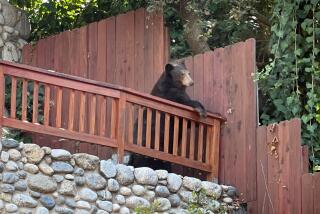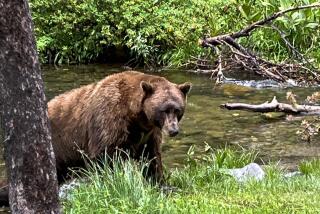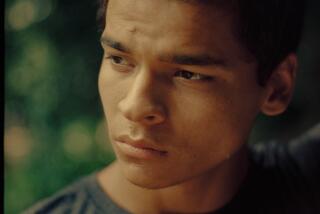Campaign to Keep Grizzlies Out of Campgrounds Goes to the Dogs
- Share via
KALISPELL, Mont. — The sow grizzly had trouble written all over her.
She was losing her fear of humans, lingering in Glacier National Park’s Two Medicine Campground. She sniffed garbage cans for food, teaching her cubs to do the same.
In short, she was headed for an early death.
But that grizzly is alive and well today in the wilds of Glacier. The difference may have been a pack of scrappy, highly trained dogs--Karelian bear dogs.
They’re not just dogs; they’re more like a reform school for bears.
Although still somewhat experimental, the dog teams are one of the best new strategies for limiting conflicts between people and bears, experts say.
“It’s a very important tool,” said Steve Gniadek, Glacier’s head biologist. “It’s cutting edge. It’s one of the most important innovations in bear management that has come along in a long time.”
The problem is old: When bears take a liking to human food, be it campground grub or the contents of rural garbage cans, it’s bad news. The bears can become dangerous and usually end up being killed.
That’s where the dogs come in.
The team includes two bear specialists for the Montana Department of Fish, Wildlife and Parks, Tim Manley and Erik Wenum, and volunteer Jeff Benkosky. They work with Carrie Hunt of the Wind River Bear Institute in Heber City, Utah. They are hired collectively by the state, Glacier Park and the Forest Service.
The stars of the team are the dogs, Gila, Tess and Finn.
“This is the only dog team doing this kind of work in the world,” Manley said.
“It’s not just the dogs alone,” Gniadek stressed. “It’s the training, the handlers and the dogs--the whole package.”
Last year, they dealt with 34 black bears and 16 grizzlies. They are entering their second field season.
“People ask me, ‘How can you teach anything to a bear?’ ” Manley said. “Well, we teach bears lessons all the time.”
But too often people teach the wrong lesson: that bears can get a free meal at campgrounds or rural homes.
The dogs teach quite a different lesson: that homes or campgrounds mean pain, noise and misery.
The dogs are bred in Finland for hunting brown bears, moose and other game. They look like a cross between a border collie and a sled dog, with muscular bodies and tightly curled tails.
As Labrador retrievers have an instinctive knack for fetching ducks, Karelians have an uncanny sense for finding bears.
“The dogs will show you all kinds of things you would have otherwise missed,” Benkosky said.
The dogs can pick up a bear trail, find scat, track bears injured by cars and trains, find orphaned cubs or radio collars that have been shed, give warning when hidden bears are nearby.
They are not hounds. They don’t chase for miles, but rather stick close to their human companion.
The dogs are key components of “aversive conditioning,” which uses negative stimuli such as noise and pain to try to teach bears to avoid trouble spots.
When the grizzly family started lingering around Two Medicine Campground, the dog team took over.
“When the bears came back, we were there waiting for them,” Manley said. “We drove them back.”
With dogs barking and people shouting and firing rubber bullets, the campground became an unpleasant place for bears.
“It doesn’t take the bear very long to figure that out,” Manley said. “After only three or four times, the bear begins to understand what is going on.”
Meanwhile, rangers make sure campers don’t leave food in the campground, which would offer the bears a positive reward.
“Removing the attractant is absolutely essential,” Manley said, noting that bears will tolerate a lot of pain and noise for easy food.
The strategy is slightly different for rural homes, where bears eat garbage, pet food or birdseed.
The old strategy was to trap the bear and release it elsewhere--usually allowing it to wander into trouble anew.
Now Manley catches the bear, fits it with a radio collar and (if the landowner agrees) releases it at the same spot where it got in trouble. When he releases the bear, he gives it a dose of harassment.
Manley sits in a turret atop his pickup camper with a shotgun loaded with nonlethal, anti-riot loads. When the bear is released, Manley thumps it in the butt.
“Usually you get two shots. By then, they’re out of range,” he said.
The dogs bark and chase, and people shout. When the bear returns to the woods, the team backs off.
But the team follows the bear by radio collar around the clock. Whenever the bear returns to a rural home, they intercept it, giving it a second dose of dogs and noise.
But again, all this work does no good if the homeowner doesn’t clean up the food that attracts the bear in the first place.
Some critics suggest that such harsh treatment will turn bears mean. Manley doubts it, noting that he always makes certain the bear has an avenue of escape so it doesn’t have to fight.
He keeps records of all the bears he works with. So far, his new tactics appear to be working.
Last fall, he worked with several grizzlies up the North Fork of the Flathead River. Under old strategies, he would have killed at least two of them.
“The idea is to keep them in the population as wild bears,” he said.
This year, he plans to contract with Wind River Bear Dogs for half the year, if he can find the money. He hopes that the state, the Forest Service and Glacier will pitch in.
It’s expensive--$10,000 a month for the full team.
But Manley says the effort can reduce conflicts later and save bears’ lives. Relocating one bear costs $1,000--often with disappointing results.
“This is an investment we can make now to save money later,” he said.
More to Read
Sign up for Essential California
The most important California stories and recommendations in your inbox every morning.
You may occasionally receive promotional content from the Los Angeles Times.










